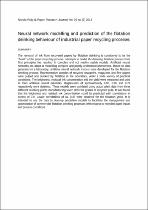 ResearchSpace
ResearchSpace
Neural network modelling and prediction of the flotation deinking behaviour of industrial paper recycling processes
JavaScript is disabled for your browser. Some features of this site may not work without it.
- ResearchSpace
- →
- Research Publications/Outputs
- →
- Journal Articles
- →
- View Item
| dc.contributor.author |
Pauck, WJ

|
|
| dc.contributor.author |
Venditti, R

|
|
| dc.contributor.author |
Pocock, J

|
|
| dc.contributor.author |
Andrew, J

|
|
| dc.date.accessioned | 2014-10-28T08:57:01Z | |
| dc.date.available | 2014-10-28T08:57:01Z | |
| dc.date.issued | 2014 | |
| dc.identifier.citation | Pauck, W.J, Venditti, R, Pocock, J and Andrew, J. 2014. Neural network modelling and prediction of the flotation deinking behaviour of industrial paper recycling processes. Nordic Pulp & Paper Research Journal, vol. 29(3), pp 521-532 | en_US |
| dc.identifier.issn | 0283-2631 | |
| dc.identifier.uri | http://www.npprj.se/html/np-viewarticleabstract.asp?m=8957&mp=750 | |
| dc.identifier.uri | http://hdl.handle.net/10204/7745 | |
| dc.description | Copyright: 2014 Arbor Publishing Ab. This is an ABSTRACT ONLY. The definitive version is published in Nordic Pulp & Paper Research Journal, vol. 29(3), pp 521-532 | en_US |
| dc.description.abstract | The removal of ink from recovered papers by flotation deinking is considered to be the “heart” of the paper recycling process. Attempts to model the deinking flotation process from first principles has resulted in complex and not readily usable models. Artificial neural networks are adept at modelling complex and poorly understood phenomena. Based on data generated in a laboratory, artificial neural network models were developed for the flotation deinking process. Representative samples of recycled newsprint, magazines and fine papers were pulped and deinked by flotation in the laboratory, under a wide variety of practical conditions. The brightness, residual ink concentration and the yield were measured and used to train artificial neural networks. Regressions of approximately 0.95, 0.85 and 0.79 respectively were obtained. These models were validated using actual plant data from three different deinking plants manufacturing seven different grades of recycled pulp. It was found that the brightness and residual ink concentration could be predicted with correlations in excess of 0.9. Lower correlations of ca. 0.43 were obtained for the flotation yield. It is intended to use the data to develop predictive models to facilitate the management and optimization of commercial flotation deinking processes with respect to recycled paper inputs and process conditions. | en_US |
| dc.language.iso | en | en_US |
| dc.publisher | Arbor Publishing Ab | en_US |
| dc.relation.ispartofseries | Workflow;13598 | |
| dc.subject | Deinking | en_US |
| dc.subject | Office wastes | en_US |
| dc.subject | Newsprint | en_US |
| dc.subject | Magazines | en_US |
| dc.subject | Flotation | en_US |
| dc.subject | Neural networks | en_US |
| dc.subject | Modelling | en_US |
| dc.subject | Process control | en_US |
| dc.title | Neural network modelling and prediction of the flotation deinking behaviour of industrial paper recycling processes | en_US |
| dc.type | Article | en_US |
| dc.identifier.apacitation | Pauck, W., Venditti, R., Pocock, J., & Andrew, J. (2014). Neural network modelling and prediction of the flotation deinking behaviour of industrial paper recycling processes. http://hdl.handle.net/10204/7745 | en_ZA |
| dc.identifier.chicagocitation | Pauck, WJ, R Venditti, J Pocock, and J Andrew "Neural network modelling and prediction of the flotation deinking behaviour of industrial paper recycling processes." (2014) http://hdl.handle.net/10204/7745 | en_ZA |
| dc.identifier.vancouvercitation | Pauck W, Venditti R, Pocock J, Andrew J. Neural network modelling and prediction of the flotation deinking behaviour of industrial paper recycling processes. 2014; http://hdl.handle.net/10204/7745. | en_ZA |
| dc.identifier.ris | TY - Article AU - Pauck, WJ AU - Venditti, R AU - Pocock, J AU - Andrew, J AB - The removal of ink from recovered papers by flotation deinking is considered to be the “heart” of the paper recycling process. Attempts to model the deinking flotation process from first principles has resulted in complex and not readily usable models. Artificial neural networks are adept at modelling complex and poorly understood phenomena. Based on data generated in a laboratory, artificial neural network models were developed for the flotation deinking process. Representative samples of recycled newsprint, magazines and fine papers were pulped and deinked by flotation in the laboratory, under a wide variety of practical conditions. The brightness, residual ink concentration and the yield were measured and used to train artificial neural networks. Regressions of approximately 0.95, 0.85 and 0.79 respectively were obtained. These models were validated using actual plant data from three different deinking plants manufacturing seven different grades of recycled pulp. It was found that the brightness and residual ink concentration could be predicted with correlations in excess of 0.9. Lower correlations of ca. 0.43 were obtained for the flotation yield. It is intended to use the data to develop predictive models to facilitate the management and optimization of commercial flotation deinking processes with respect to recycled paper inputs and process conditions. DA - 2014 DB - ResearchSpace DP - CSIR KW - Deinking KW - Office wastes KW - Newsprint KW - Magazines KW - Flotation KW - Neural networks KW - Modelling KW - Process control LK - https://researchspace.csir.co.za PY - 2014 SM - 0283-2631 T1 - Neural network modelling and prediction of the flotation deinking behaviour of industrial paper recycling processes TI - Neural network modelling and prediction of the flotation deinking behaviour of industrial paper recycling processes UR - http://hdl.handle.net/10204/7745 ER - | en_ZA |





